Scenario Analysis of Cost-Effectiveness of Maintenance Strategies for Fixed Tidal Stream Turbines in the Atlantic Ocean
Abstract
:1. Introduction
2. Methodology
2.1. Site-Specific Weather Condition Statistics
2.2. Tidal Device Specification and Energy Production
- Rotor blades, which capture the kinetic energy of the moving water.
- Hub, the central part of the turbine that connects the rotor blades to the generator. It typically consists of a hub housing and a shaft.
- Generator, which is responsible for converting the mechanical energy of the rotating rotor into electrical energy. It is typically located inside the nacelle, which is mounted on top of the tower.
- Control system, which monitors and regulates the operation of the turbine, including the speed of the rotor and the output of the generator. It may also include sensors to monitor environmental conditions such as tidal currents, water depth, and temperature.
- Power transmission system, which is responsible for transmitting the electrical energy generated by the turbine to the shore. It typically consists of underwater cables, a substation, and a connection to the grid.
- A ballast-weight foundation that provides a stable base for the turbine.
2.3. Failure Data Input
2.3.1. Failure Event Distribution
2.4. Weather Window Limit, Vessel Transit Time, and Costs
3. Results and Discussion
3.1. O&M Metrics and Discussion
3.2. Sensitivity Analysis
4. Conclusions
Author Contributions
Funding
Data Availability Statement
Conflicts of Interest
References
- European Commission. Boosting Offshore Renewable Energy for a Climate Neutral Europe. 2020. Available online: https://ec.europa.eu/commission/presscorner/detail/en/IP_20_2096 (accessed on 8 December 2022).
- Lewis, M.; Hara, R.O.; Fredriksson, S.; Maskell, J.; De Fockert, A.; Neill, S.P.; Robins, P.E. A standardised tidal-stream power curve, optimised for the global resource. Renew. Energy 2021, 170, 1308–1323. [Google Scholar] [CrossRef]
- Yang, Z.; Ren, Z.; Li, Z.; Xu, Y.; Li, H.; Li, W.; Hu, X. A comprehensive analysis method for levelized cost of energy in tidal current power generation farms. Renew. Energy 2022, 182, 982–991. [Google Scholar] [CrossRef]
- Collombet, R. Ocean Energy Key Trends and Statistics 2019; Ocean Energy Europe: Brussels, Belgium, 2020; pp. 10–13. [Google Scholar]
- Sleiti, A.K. Tidal power technology review with potential applications in Gulf Stream. Renew. Sustain. Energy Rev. 2017, 69, 435–441. [Google Scholar] [CrossRef]
- Hodges, J.; Henderson, J.; Ruedy, L.; Soede, M.; Weber, J.; Ruiz-Minguela, P.; Jeffrey, H.; Bannon, E.; Holland, M.; Maciver, R.; et al. An International Evaluation and Guidance Framework for Ocean Energy Technology 2O21 2-Task 12. IAn Int. Eval. Guid. Fram. Ocean Energy Technoglogy. IEA-OES. 2021. Available online: www.formasdopossivel.com (accessed on 20 April 2023).
- Nachtane, M.; Tarfaoui, M.; Goda, I.; Rouway, M. A review on the technologies, design considerations and numerical models of tidal current turbines. Renew. Energy 2020, 157, 1274–1288. [Google Scholar] [CrossRef]
- Segura, E.; Morales, R.; Somolinos, J.A.; López, A. Techno-economic challenges of tidal energy conversion systems: Current status and trends. Renew. Sustain. Energy Rev. 2017, 77, 536–550. [Google Scholar] [CrossRef]
- Walker, S.; Thies, P.R. A review of component and system reliability in tidal turbine deployments. Renew. Sustain. Energy Rev. 2021, 151, 111495. [Google Scholar] [CrossRef]
- Magagna, D.; Margheritini, L.; Alessi, A.; Bannon, E.; Boelman, E.; Bould, D.; Coy, V.; De Marchi, E.; Frigaard, P.; Guedes Soares, C.; et al. Workshop on Identification of Future Emerging Technologies in the Ocean Energy Sector; 27 March 2018, Ispra, Italy, EUR 29315 EN; JRC112635; European Commission: Luxembourg, 2018; ISBN 978-92-79-92587-0/978-92-79-92586-3. [CrossRef]
- Word Economic Forum. A New Tidal Energy Project Just Hit a Major Milestone in Scotland. 2020. Available online: https://www.weforum.org/agenda/2020/01/tidal-renewable-energy-turbine-electricity-generation-scotland/ (accessed on 10 August 2022).
- Lopez, A.; Moran, J.L.; Nunez, L.R.; Somolinos, J. Study of a cost model of tidal energy farms in early design phases with parametrization and numerical values. Application to a second-generation device. Renew. Sustain. 2020, 117, 109497. [Google Scholar] [CrossRef]
- Neary, V.S.; Previsic, M.; Jepsen, R.A.; Lawson, M.J.; Yu, Y.; Copping, A.E.; Fontaine, A.A.; Hallett, K.C.; Murray, D.K. Methodology for Design and Economic Analysis of Marine Energy Conversion (MEC) Technologies; SANDIA REPORT; SAND2014-9040; Sandia National Laboratories: Livermore, CA, USA, 2014. [Google Scholar]
- European Commission. LCEO Ocean Energy Technology Development Report 2018 EUR 29907 EN; European Commission: Brussels, Belgium, 2019.
- European Union. An EU Strategy to Harness the Potential of Offshore Renewable Energy for a Climate Neutral Future; European Union: Luxembourg, 2020; p. 27. [Google Scholar]
- Ioannou, A.; Angus, A.; Brennan, F. A lifecycle techno-economic model of offshore wind energy for different entry and exit instances. Appl. Energy 2018, 221, 406–424. [Google Scholar] [CrossRef]
- Smart, G.; Noonan, M. Tidal Stream and Wave Energy Cost Reduction and Industrial Benefit: Summary Analysis. no. April. 2018, p. 21. Available online: https://www.marineenergywales.co.uk/wp-content/uploads/2018/05/ORE-Catapult-Tidal-Stream-and-Wave-Energy-Cost-Reduction-and-Ind-Benefit-FINAL-v03.02.pdf (accessed on 20 September 2022).
- Rinaldi, G.; Portillo, J.C.C.; Khalid, F.; Henriques, J.C.C.; Thies, P.R.; Gato, L.M.C.; Johanning, L. Multivariate analysis of the reliability, availability, and maintainability characterizations of a Spar–Buoy wave energy converter farm. J. Ocean Eng. Mar. Energy 2018, 4, 199–215. [Google Scholar] [CrossRef]
- BVG Associates. A Guide to an Offshore Wind Farm Updated and Extended. Publ. Behalf Crown Estate Offshore Renew. Energy Catapult, no. January. 2019, pp. 1–70. Available online: http://www.thecrownestate.co.uk/guide_to_offshore_windfarm.pdf (accessed on 25 April 2023).
- Rinaldi, G.; Garcia-Teruel, A.; Jeffrey, H.; Thies, P.R.; Johanning, L. Incorporating stochastic operation and maintenance models into the techno-economic analysis of floating offshore wind farms. Appl. Energy 2021, 301, 117420. [Google Scholar] [CrossRef]
- Lazakis, I.; Khan, S. An optimization framework for daily route planning and scheduling of maintenance vessel activities in offshore wind farms. Ocean Eng. 2021, 225, 108752. [Google Scholar] [CrossRef]
- Neves-Moreira, F.; Veldman, J.; Teunter, R.H. Service operation vessels for offshore wind farm maintenance: Optimal stock levels. Renew. Sustain. Energy Rev. 2021, 146, 111158. [Google Scholar] [CrossRef]
- Stålhane, M.; Vefsnmo, H.; Halvorsen-Weare, E.E.; Hvattum, L.M.; Nonås, L.M. Vessel Fleet Optimization for Maintenance Operations at Offshore Wind Farms under Uncertainty. Energy Procedia 2016, 94, 357–366. [Google Scholar] [CrossRef]
- Lande-Sudall, D.; Stallard, T.; Stansby, P. Co-located deployment of offshore wind turbines with tidal stream turbine arrays for improved cost of electricity generation. Renew. Sustain. Energy Rev. 2019, 104, 492–503. [Google Scholar] [CrossRef]
- Kolios, A.; Di Maio, L.F.; Wang, L.; Cui, L.; Sheng, Q. Reliability assessment of point-absorber wave energy converters. Ocean Eng. 2018, 163, 40–50. [Google Scholar] [CrossRef]
- Ren, Z.; Shankar, A.; Li, Y.; Teuwen, J.J.E.; Jiang, Z. Offshore wind turbine operations and maintenance : A state-of-the-art review. Renew. Sustain. Energy Rev. 2021, 144, 110886. [Google Scholar] [CrossRef]
- Karyotakis, A.; Bucknall, R. Planned intervention as a maintenance and repair strategy for offshore wind turbines. J. Mar. Eng. Technol. 2010, 9, 27–35. [Google Scholar] [CrossRef]
- Vieira, M.; Henriques, E.; Snyder, B.; Reis, L. Insights on the impact of structural health monitoring systems on the operation and maintenance of offshore wind support structures. Struct. Saf. 2022, 94, 102154. [Google Scholar] [CrossRef]
- Judge, F.; McAuliffe, F.D.; Sperstad, I.B.; Chester, R.; Flannery, B.; Lynch, K.; Murphy, J. A lifecycle financial analysis model for offshore wind farms. Renew. Sustain. Energy Rev. 2019, 103, 370–383. [Google Scholar] [CrossRef]
- Lewis, M.; Neill, S.P.; Robins, P.; Hashemi, M.R.; Ward, S. Characteristics of the velocity profile at tidal-stream energy sites. Renew. Energy 2017, 114, 258–272. [Google Scholar] [CrossRef]
- Coles, D.; Angeloudis, A.; Goss, Z.; Miles, J. Tidal stream vs. wind energy: The value of predictable, cyclic power generation in off-grid hybrid systems. Energies 2021, 14, 1106. [Google Scholar] [CrossRef]
- Vennell, R.; Major, R.; Zyngfogel, R.; Beamsley, B.; Smeaton, M.; Scheel, M.; Unwin, H. Rapid initial assessment of the number of turbines required for large-scale power generation by tidal currents. Renew. Energy 2020, 162, 1890–1905. [Google Scholar] [CrossRef]
- Deng, G.; Zhang, Z.; Li, Y.; Liu, H.; Xu, W.; Pan, Y. Prospective of development of large-scale tidal current turbine array: An example numerical investigation of Zhejiang, China. Appl. Energy 2020, 264, 114621. [Google Scholar] [CrossRef]
- Faizan, M.; Badshah, S.; Badshah, M.; Haider, B.A. Performance and wake analysis of horizontal axis tidal current turbine using Improved Delayed Detached Eddy Simulation. Renew. Energy 2022, 184, 740–752. [Google Scholar] [CrossRef]
- Nuernberg, M.; Tao, L. Experimental study of wake characteristics in tidal turbine arrays. Renew. Energy 2018, 127, 168–181. [Google Scholar] [CrossRef]
- Ouro, P.; Ramírez, L.; Harrold, M. Analysis of array spacing on tidal stream turbine farm performance using Large-Eddy Simulation. J. Fluids Struct. 2019, 91, 102732. [Google Scholar] [CrossRef]
- Segura, E.; Morales, R.; Somolinos, J.A. Cost assessment methodology and economic viability of tidal energy projects. Energies 2017, 10, 1806. [Google Scholar] [CrossRef]
- Larsson, J. Transmission Systems for Grid Connection of Offshore Wind Farms HVAC vs HVDC Breaking Point; UPTEC ES 21010; Uppsala University: Uppsala, Sweden, 2021; ISSN 1650-8300. [Google Scholar]
- Taketomi, N.; Yamamoto, K.; Chesneau, C.; Emura, T. Parametric Distributions for Survival and Reliability Analyses, a Review and Historical Sketch. Mathematics 2022, 10, 3907. [Google Scholar] [CrossRef]
- Cain, N. Distinguishing between lognormal and Weibull distributions -time-to-failure data. IEEE Trans. Reliab. 2002, 51, 28–32. [Google Scholar] [CrossRef]
- Bromideh, A. Discriminating Between Weibull and Log-Normal Distributions Based on Kullback-Leibler Divergence. Ekonom. ve İstatistik e-Dergisi 2012, 16, 44–54. [Google Scholar]
- Wang, J.; Zhao, X.; Guo, X. Optimizing wind turbine’s maintenance policies under performance-based contract. Renew. Energy 2019, 135, 626–634. [Google Scholar] [CrossRef]
- Abdollahzadeh, H.; Atashgar, K.; Abbasi, M. Multi-objective opportunistic maintenance optimization of a wind farm considering limited number of maintenance groups. Renew. Energy 2016, 88, 247–261. [Google Scholar] [CrossRef]
- Herbert, G.M.J.; Iniyan, S.; Goic, R. Performance, reliability and failure analysis of wind farm in a developing Country. Renew. Energy 2010, 35, 2739–2751. [Google Scholar] [CrossRef]
- Mudholkar, G.S.; Srivastava, D.K.; Kollia, G.D. A generalization of the Weibull distribution with application to the analysis of survival data. J. Am. Stat. Assoc. 1996, 91, 1575–1583. [Google Scholar] [CrossRef]
- Thies, P.; Johanning, L.; Smith, G. Towards component reliability testing for marine energy converters. Ocean Eng. 2011, 38, 360–370. [Google Scholar] [CrossRef]
- Nguyen, T.A.T.; Chou, S.Y. Improved maintenance optimization of offshore wind systems considering effects of government subsidies, lost production and discounted cost model. Energy 2019, 187, 115909. [Google Scholar] [CrossRef]
- Papoulis, A.; Pillai, S.U. Probability, Random Variables, and Stochastic Processes, 4th ed.; McGraw-Hill: Boston, MA, USA, 2002; ISBN 0-07-366011-6. [Google Scholar]
- De Andrés, A.; Macgillivray, A.; Guanche, R.; Jeffrey, H. Factors affecting LCOE of Ocean energy technologies: A study of technology and deployment attractiveness. In Proceedings of the 5th International Conference on Ocean Energy, Halifax, NS, Canada, 4–6 November 2014; pp. 1–11. Available online: https://inore-yaronguez.netdna-ssl.com/wp-content/uploads/2015/02/AdeAndres_AMacGillivray-2.pdf (accessed on 5 September 2022).
- Gray, A.; Dickens, B.; Bruce, T.; Ashton, I.; Johanning, L. Reliability and O&M sensitivity analysis as a consequence of site specific characteristics for wave energy converters. Ocean Eng. 2017, 141, 493–511. [Google Scholar] [CrossRef]
- OES-IEA. International Levelised Cost of Energy for Ocean Energy Technologies. 2015. Available online: https://www.ocean-energy-systems.org/oes-projects/levelised-cost-of-energy-assessment-for-wave-tidal-and-otec-at-an-international-level/ (accessed on 5 February 2023).
- Meygen Ltd. Lessons Learnt from MeyGen Phase 1A Part 2/3: Construction Phase. no. May. 2018; p. 15. Available online: https://tethys.pnnl.gov/sites/default/files/publications/MeyGen-2017-Part1.pdf (accessed on 5 September 2022).
- Frost, C. Cost Reduction Pathway of Tidal Stream Energy in the UK and France. TIGER Project 2019–2023. 2022. Available online: https://ore.catapult.org.uk/?orecatapultreports=cost-reduction-pathway-of-tidal-stream-energy-in-the-uk-and-france (accessed on 11 May 2023).
- Stehly, T.; Duffy, P. 2020 Cost of Wind Energy Review. National Renewable Energy Laboratory. NREL/TP-5000-81209. Rep., no. December. 2021; p. 68. National Renewable Energy Laboratory. NREL/TP-5000-81209. Available online: https://www.nrel.gov/docs/fy22osti/81209.pdf (accessed on 11 May 2023).


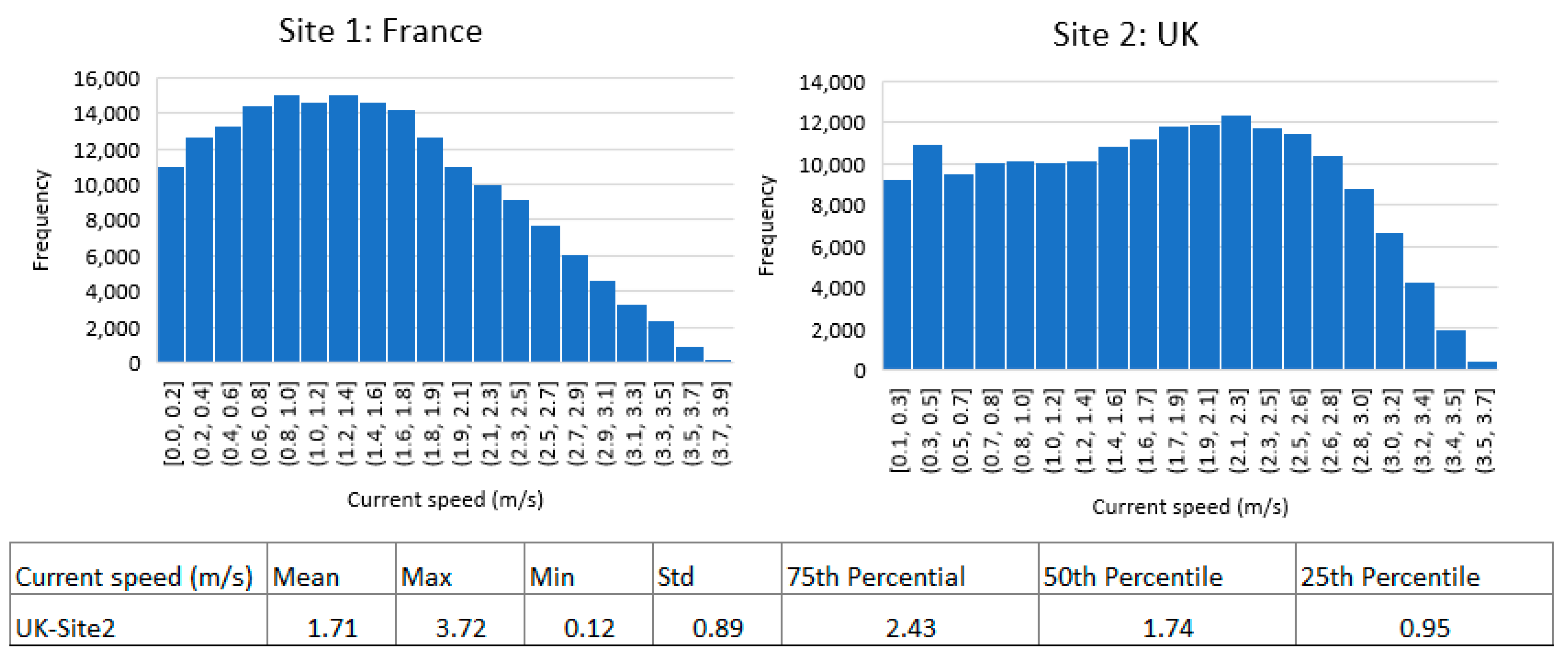

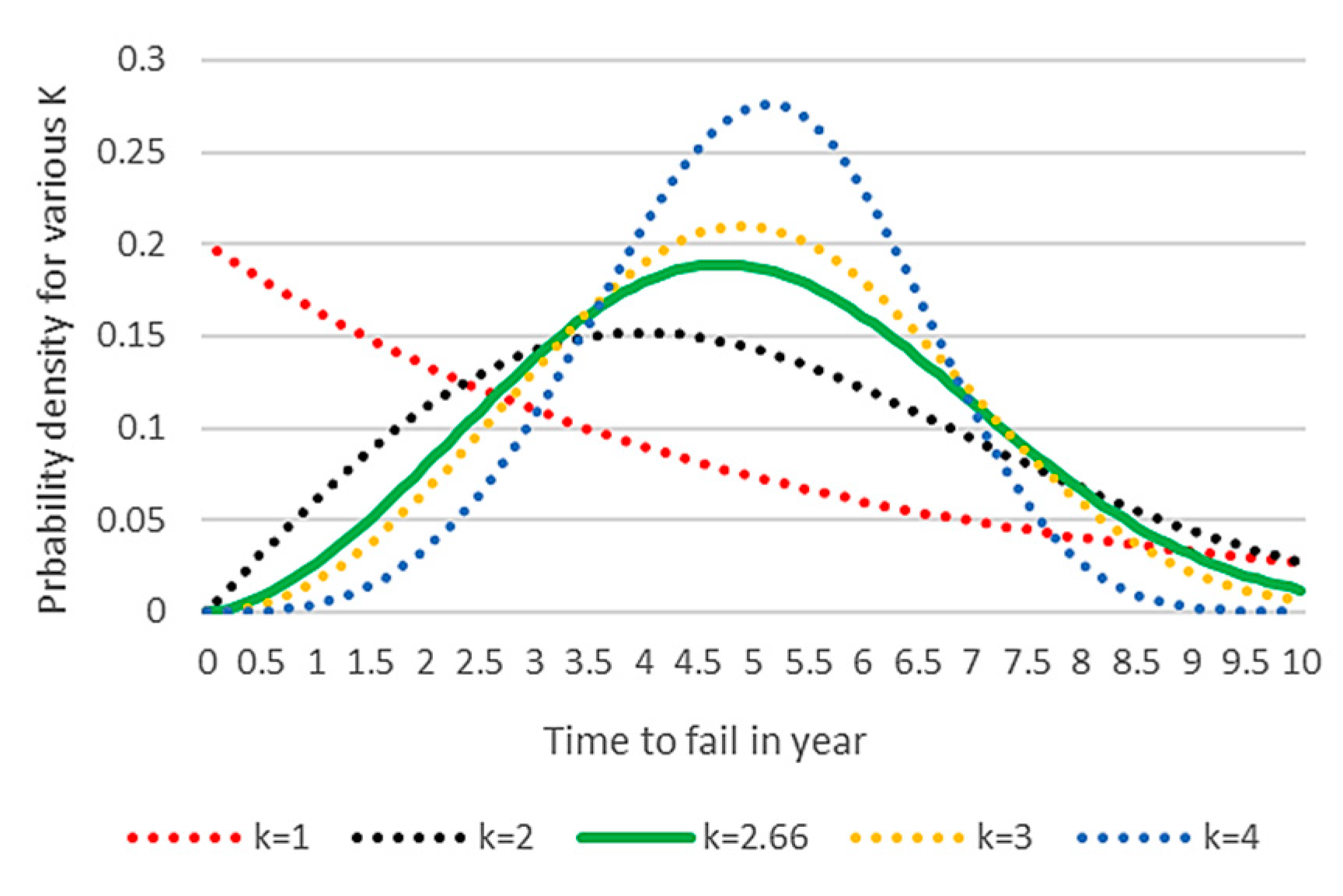
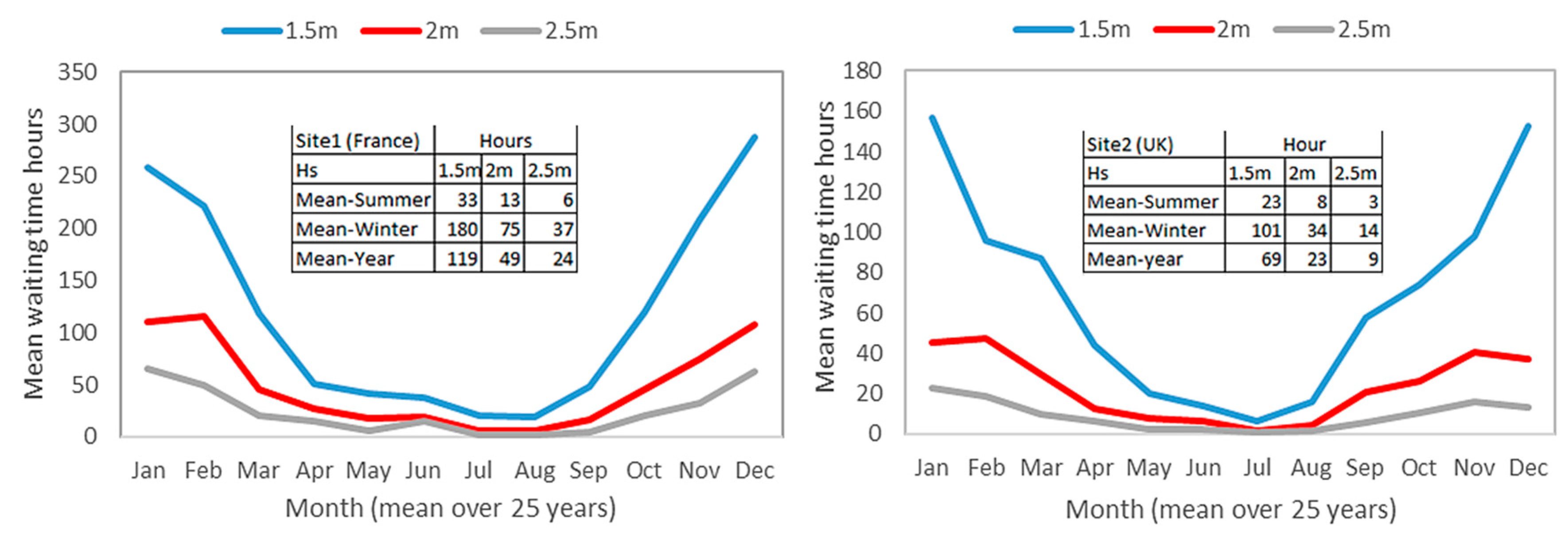

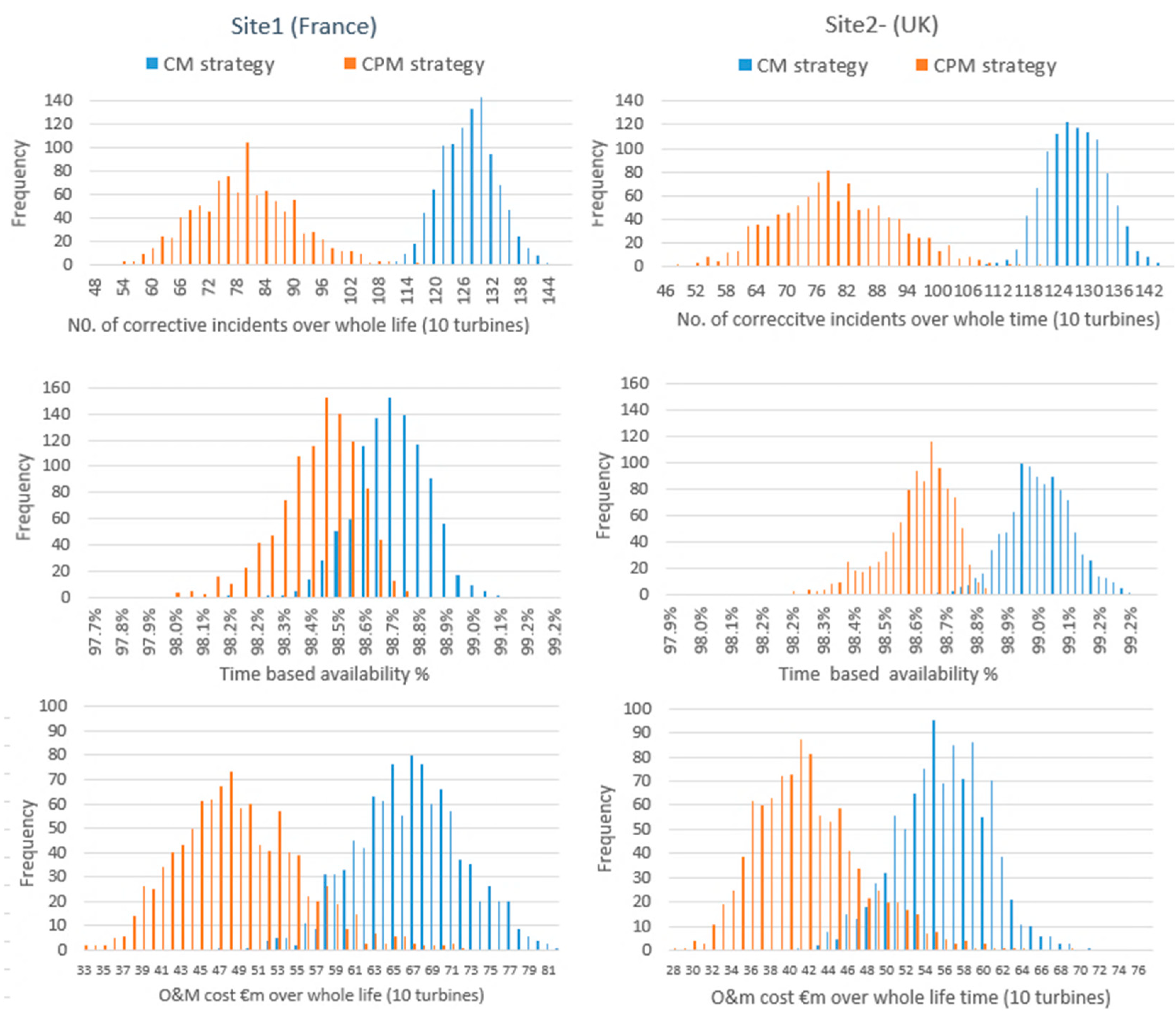

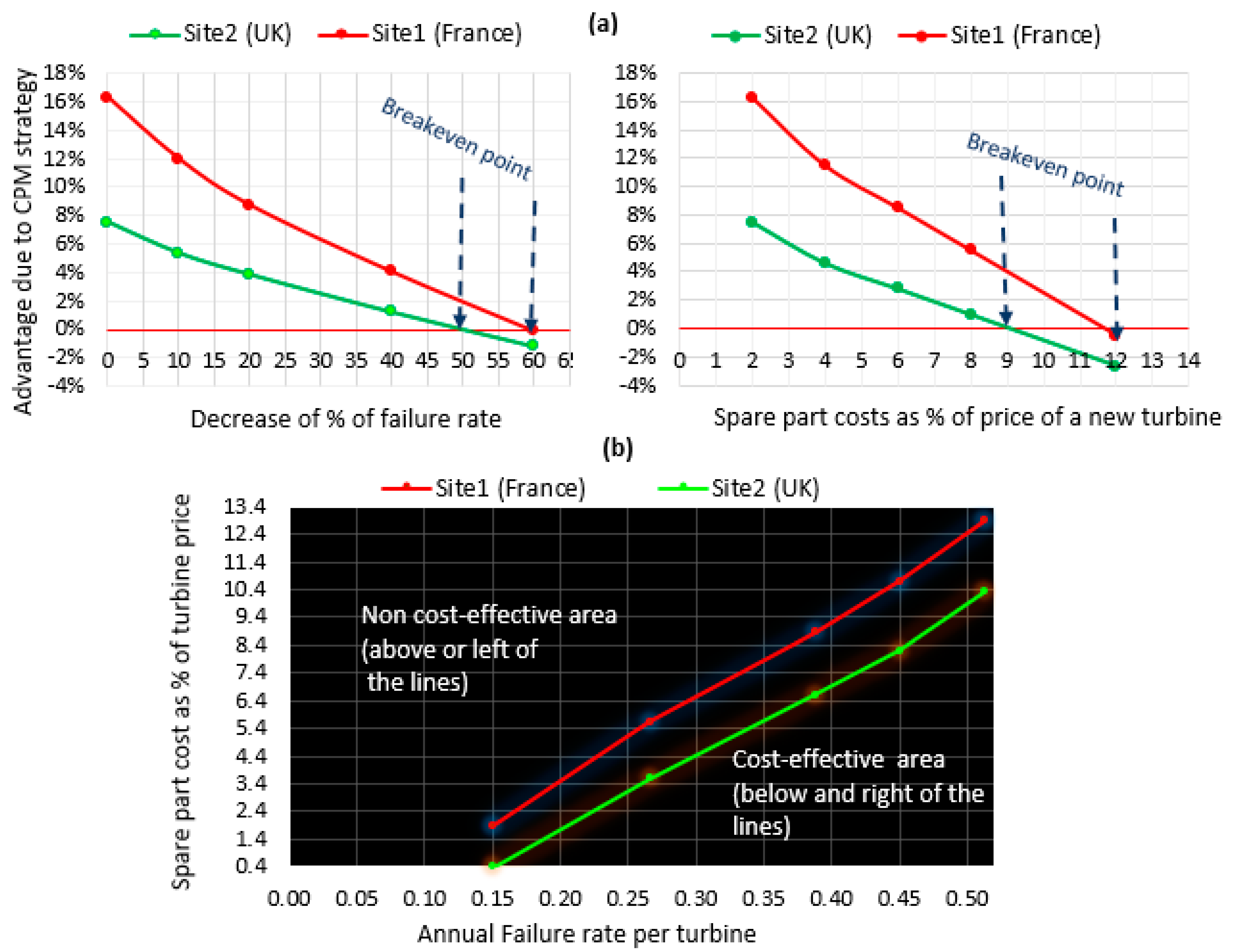
| Steps | Brief Description |
|---|---|
| 1. Calculate Weibull parameters for each component using the annual failure rate. | A Weibull distribution is used to simulate the time between failures for the components as described in Section 2.3.1. The mean time between failures is the reciprocal of the annual failure rate. |
| 2. Randomly select the failure time. | Using the Weibull distribution, a random time since the previous failure is selected (or the random time since the component was first used). |
| 3. Calculate the weather window waiting time. | The length of time to repair the component (see Table 2) and the travel time to and from its site (see Table 3) are all known. With this information, the Metocean data is searched to find a weather window that has acceptable wave height and wind speed for the vessel(s) that are needed for repair/maintenance. The start time for this weather window is set to 8 a.m. so that journeys will be made in daylight. It is assumed that weather forecasting is accurate enough to find the weather window. Knowing the waiting time for a weather window and the time required to mobilise the vessel(s), it is then possible to order a vessel to arrive at the start of the weather window. |
| 4. Retrieve the turbine offshore, return the turbine to the facility port, carry out (onshore) repair, decide to hold on to the vessel(s) or re-hire them when the turbine is returned to function in the farm, and calculate the downtime. | Calculate the time for the journey to and from the farm, the time to retrieve and re-install the device offshore (see Table 3), and the time to repair it onshore (Table 2). The decision then is whether to keep the vessel on site while the repair is carried out or to send the vessel(s) back and re-hire them. The criterion for this is to decide whether the hiring cost of the time spent waiting for the repair to be completed and the waiting time for the next weather window is more expensive or less expensive than the mobilisation cost of the vessel(s). When the turbine is returned to operation on the farm, this ends the downtime. During downtime, there is a 100% loss of power. |
| 5. Repeat steps 2, 3, and 4 until the project’s lifetime is complete. | The process of repeated repair is continued until the sum of the elapsed time exceeds the lifetime of the project. |
| Component | Annual Failure Rate (%) | Time to Repair (h) | Spare-Part Cost € | No. of Technicians |
|---|---|---|---|---|
| Drivetrain | 44 | 60 | 45,000 | 4 |
| Electric system | 17 | 5 | 3500 | 2 |
| Nacelle | 12 | 60 | 35,000 | 6 |
| Blade | 9 | 7 | 2500 | 2 |
| Support structure | 6 | 500 | 200,000 | 8 |
| Pitch system | 4 | 44 | 8000 | 4 |
| Gearbox | 4 | 45 | 70,000 | 4 |
| Power convertor | 2 | 50 | 15,000 | 4 |
| Generator | 2 | 140 | 25,000 | 4 |
| Control system | 1 | 45 | 4000 | 2 |
| Sum | 100 | 956 | 408,000 | 40 |
| Dynamic Positioning (DP) Multipurpose | Unit | Value |
|---|---|---|
| Average speed (1 knot ≈ 1.852 km/h) | knots | 6 |
| Average fuel consumption (transit) | l/hr | 596 |
| Average fuel consumption (standby) | l/hr | 448 |
| Average fuel price | €/l | 0.48 |
| Mobilisation cost | € | 50,000 |
| Mobilisation time | hour | 48 |
| Operational day rate | €/day | 40,000 |
| Retrieving time of the device (offshore) | hr | 6 |
| Reinstallation time of the device (offshore) | hr | 6 |
| A summary of vessel cost calculations | ||
| ||
| ||
| ||
| ||
| CM Strategy | CPM Strategy | Advantage (CPM-CM)/CM | ||||
|---|---|---|---|---|---|---|
| Annual Mean Per Turbine | Site1 France | Site2 UK | Site1 France | Site2 UK | Site1 France | Site2 UK |
| Number of corrective incidents | 0.51 | 0.51 | 0.32 | 0.32 | −37% | −37% |
| Time-based availability | 98.7% | 99.0% | 98.5% | 98.6% | −0.2% | −0.4% |
| Downtime hour | 114 | 88 | 131 | 123 | −0.2% | −0.4% |
| Theoretical energy (MWh) | 3840 | 5130 | 3840 | 5130 | - | - |
| Delivered energy (MWh) | 3482 | 4665 | 3476 | 4651 | −0.2% | −0.3% |
| Gross Income (€) | 696,413 | 932,910 | 695,143 | 930,276 | −0.2% | −0.3% |
| Vessel cost (chartered and fuel) (€) | 239,203 | 195,768 | 154,784 | 126,451 | −35% | −35% |
| Spare-part cost (€) | 20,386 | 20,427 | 25,452 | 25,506 | 25% | 25% |
| Cost of technicians | 9507 | 9529 | 17,984 | 18,015 | 89% | 89% |
| Annual variable O&M cost (€/turbine/year) | 269,096 | 225,724 | 198,221 | 169,972 | −26% | −25% |
| Net income (€/turbine/year) | 427,317 | 707,186 | 496,922 | 760,304 | 16% | 7.5% |
Disclaimer/Publisher’s Note: The statements, opinions and data contained in all publications are solely those of the individual author(s) and contributor(s) and not of MDPI and/or the editor(s). MDPI and/or the editor(s) disclaim responsibility for any injury to people or property resulting from any ideas, methods, instructions or products referred to in the content. |
© 2023 by the authors. Licensee MDPI, Basel, Switzerland. This article is an open access article distributed under the terms and conditions of the Creative Commons Attribution (CC BY) license (https://creativecommons.org/licenses/by/4.0/).
Share and Cite
Kamidelivand, M.; Deeney, P.; McAuliffe, F.D.; Leyne, K.; Togneri, M.; Murphy, J. Scenario Analysis of Cost-Effectiveness of Maintenance Strategies for Fixed Tidal Stream Turbines in the Atlantic Ocean. J. Mar. Sci. Eng. 2023, 11, 1046. https://doi.org/10.3390/jmse11051046
Kamidelivand M, Deeney P, McAuliffe FD, Leyne K, Togneri M, Murphy J. Scenario Analysis of Cost-Effectiveness of Maintenance Strategies for Fixed Tidal Stream Turbines in the Atlantic Ocean. Journal of Marine Science and Engineering. 2023; 11(5):1046. https://doi.org/10.3390/jmse11051046
Chicago/Turabian StyleKamidelivand, Mitra, Peter Deeney, Fiona Devoy McAuliffe, Kevin Leyne, Michael Togneri, and Jimmy Murphy. 2023. "Scenario Analysis of Cost-Effectiveness of Maintenance Strategies for Fixed Tidal Stream Turbines in the Atlantic Ocean" Journal of Marine Science and Engineering 11, no. 5: 1046. https://doi.org/10.3390/jmse11051046
APA StyleKamidelivand, M., Deeney, P., McAuliffe, F. D., Leyne, K., Togneri, M., & Murphy, J. (2023). Scenario Analysis of Cost-Effectiveness of Maintenance Strategies for Fixed Tidal Stream Turbines in the Atlantic Ocean. Journal of Marine Science and Engineering, 11(5), 1046. https://doi.org/10.3390/jmse11051046







